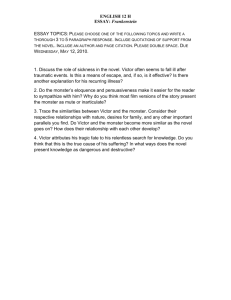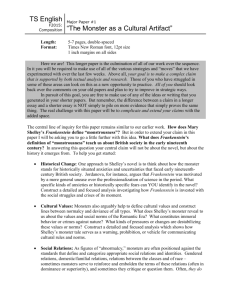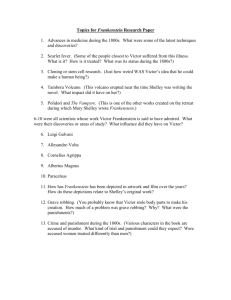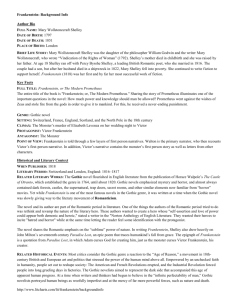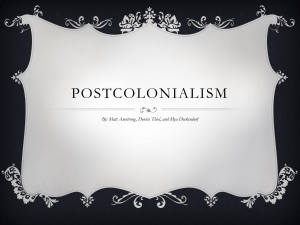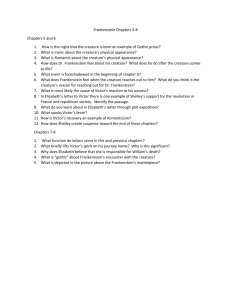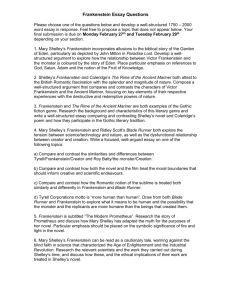frankenstein-unit - Calhoun County Schools
advertisement
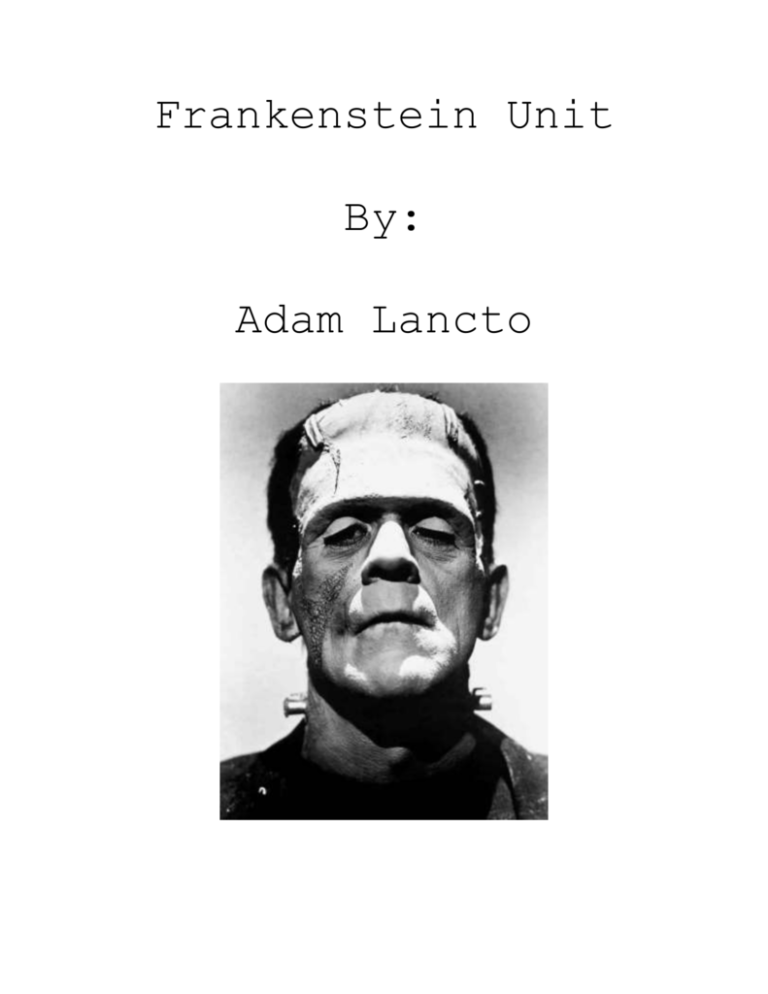
Frankenstein Unit By: Adam Lancto Introduction This unit has been developed to enhance student’s skills in reading, writing, critical thinking, vocabulary, and comprehension through exercises and assignments related to the novel Frankenstein by Mary Shelley. Each step in the unit is a step towards the final assessment which is a critical literary analysis essay. The introductory lesson introduces students to the epic poem “Paradise Lost” by John Milton and the story of Satan’s fall from heaven. The reason I have chosen to start with this lesson is that is gives students an opportunity to be acquainted with the story since it plays a central role in the novel thematically and comprehensively. Also, it gets the students ready to discover what they see or read might not always be truthful. With this lesson I use a picture of Satan when he was an angel and ask them to describe the picture without telling them it is Satan. During the novel it is imperative to always be wondering if the story we are getting about the monster is accurate. Therefore, coming back to the idea of not taking everything we see at face value. The background lesson that comes after the introductory lesson is used as a “hook” to spark student’s interest in the novel and the unit. Here I use a quick survey which asks the students whether they believe technology should be used in a number of circumstances which gradually become more controversial. The last two questions deal with the question of cloning and creating life with technology. The idea is to initiate a debate about the uses of technology and knowledge which will be the major theme addressed throughout this unit. After the debate, I introduce the student’s to the central theme of Frankenstein which is ‘Dangerous Knowledge’ and how this novel’s message can be very relevant in our world today. Lastly, this lesson is aimed at getting students introduced to the author Mary Shelley and her motives and inspiration behind the book. Also, I reinforce the idea that Frankenstein is not a green monster with bolts in his neck. The quizzes that are used were meant to check the student’s reading as well as make them responsible for the material. I noticed that kids were not reading so to make them accountable I made the quizzes up so there was punishment for not reading. I felt that this was needed since there was hardly any additional work after we discussed the material and read aloud in class. Now, after awhile the quizzes became ineffective so a different method was needed. However, it is good to have some sort of assessment in quiz form at the beginning I found to make them understand there are consequences for not reading. The activities/assignments involved with this unit were quick but important. They were used to solidify what was being talked about during the reading. Assignments were not given after each lesson which helped strengthen the learning when we did have work. They worked on skills in writing with the ‘create your own monster’ and critical thinking with the stem cell worksheet. These both were done as group activities which helped them gather ideas and use them effectively as well as made them work on their skill of working within groups. With vocabulary was intended to expose the students to the words they would be reading and be able to comprehend them. A series of 7 words were selected and given to the students to study and use for different warm up activities. The idea is to not give them so many words that they will lose track. Instead concentrate on a small number of words more in depth to really grasp an understanding of them. It began with first the definition of the word then how to use the word in the proper context. The final assessment was an activity where the students were to write 7 sentences using the word properly in context. In order to connect the theme of ‘Dangerous Knowledge’ within Frankenstein to modern day society I used an article on stem cell research. This interdisciplinary material was very beneficial since there is a lot of science talk within the story itself. The article “Stemming the Debate: Advances in Stem Cell Research” was published in the Michigan Science magazine in 2008. This article sparked a lot of interest due to the state wide election on stem cell research and just general opinions on the subject. Students should be able to use the article to draw parallels to Victor’s research with creating life and the idea of stem cell research ‘creating’ life as well. The final formal assessment comes with writing a formal essay on the theme of ‘Dangerous Knowledge’. Students must learn how to devise an argument and support their claim with the novel and other resources in order to justify their side of the debate. Students will learn how to properly write a literary analysis using the MLA format with the completion of the essay. Also, the essay allows students the opportunity to defend whatever side they have chosen, while also building skills in explaining what the mean by giving specific examples. The essay will be graded with a standard rubric put forth by the school district. Daily assessment will be done with either the quizzes or class discussion activities. These methods will be quick and easy to check for understanding and how well they are achieving the objectives set forth by the unit plan. There were few modifications for this unit in regard to individual students with the exception of an alternate essay expectation for special need students. The reading assignments were broken down into a maximum of 20 page loads, with a lot of in class reading by the teacher to help understanding and cut the load down. This is a very manageable amount of reading for a block schedule which this unit was designed for. Unit Objectives Driving Question: What specific lessons about knowledge, companionship, and responsibility can I learn from reading Frankenstein by Mary Shelley that I can apply to my life? Sub-Driving Questions (Key Questions): How do the characters of Frankenstein compare to those of “Paradise Lost?” What is a frame narrative and how does it work in Frankenstein? Explain the characteristics of a gothic horror novel What are the major themes within the novel How does stem cell research and other modern technology relate to the warning of knowledge within the novel? Describe the importance of looking at the conflict in the novel from different perspectives Explain how to properly write a literary analysis essay using MLA format Michigan High School English Language Arts Content Expectation *The following are all of the content expectations met by this unit* Strand 1: Standard 1.1 (CE 1.1.1) (CE 1.1.2) (CE 1.1.4) Standard 1.2 (CE 1.2.3) Standard 1.3 (CE 1.3.1) (CE1.3.2) (CE 1.3.3) (CE 1.3.7) Standard 1.5 (CE1.5.4) Strand 2: Standard 2.1 (CE 2.1.1) (CE 2.1.5) Standard 2.2 (CE 2.2.3) Standard 2.3 (CE 2.3.4) Strand 3: Standard 3.1 (CE 3.1.1) (CE 3.1.2) (CE 3.1.3) (CE 3.1.5) (CE 3.1.10) Standard 3.2 (CE 3.2.4) (CE 3.2.5) Standard 3.3 (CE 3.3.2) (CE 3.3.3) Strand 4: Standard 4.1 (CE 4.1.1) Culminating Project Sub-Driving Question: How can I effectively support my opinion on the idea of knowledge being dangerous in a critical essay with different texts? Subject: British Literature 11th grade Topic: Essay Titles Objective: Students will be able to connect a theme from the novel Frankenstein by Mary Shelly with supplemental readings given in class. Materials: 1) Frankenstein by Mary Shelly 2) “Stemming the Debate” article 3) Class notes 4) Chapter Summaries Assessment: I will know that students will be able to connect Frankenstein with supplemental readings thematically when they have successfully written their essays according to the rubric. Essay Title: *Throughout the novel, Mary Shelly warns of the danger that knowledge may posses. Victor states, “Learn from me, if not by my precepts, at least by my example, how dangerous is the acquirement of knowledge and how much happier that man is who believes his native town to be the world, then he who aspires to become greater than his nature will allow.” Even today this warning is relevant in our increasingly changing society. Devise an argument to either support or deny Victor Frankenstein’s warning about the acquirement of knowledge being dangerous (Think about what happened due to Victor creating the monster AND what happened to the monster when he began to learn about the world). Make sure to bring in modern day examples to support your argument. Expectations for Essay: *3-5 pgs. *MLA format *Reference “Stemming the Debate” article *Works Cited page *Clear thesis sentence that explains your argument *Interesting title and opening sentence **You should develop YOUR OWN argument from your own feelings and ideas. There is NO wrong answer to the question but you must support your argument effectively with examples from the book and Stem Cell article** Lesson 1 10/13/2008 Subject: British Literature 11th grade Topic: Paradise Lost (Satan’s Fall) Objective: Students will be able to explain why Satan was kicked out of Heaven Materials: 1) “Paradise Lost” by John Milton 2) Picture of Satan as an Angel 3) British Literature textbook Assessment: I will know that students will be able to explain why Satan was kicked out of Heaven when they have successfully finished answering the questions after the reading. Instruction: *Warm up: Satan as an Angel picture * Introduce Milton and Paradise Lost * Begin reading Paradise Lost * Discuss the idea of “better to rule in Hell than serve in Heaven” And ask if Satan is a bad person JUST from what they read *Assign questions in book (2, 3, 5, 13, 15, and personal writing) Reflection: Lesson 2 Subject: British Literature Topic: Introduction to Frankenstein By: Mary Shelley Objective: Students will be able to identify who Mary Shelley was and her purpose for writing Frankenstein. Students will be able to fully understand the characteristics of a gothic horror novel. Materials: 1) Mary Shelley bio outline 2) Embracing technology worksheet 3) Background notes with Power Point 4) “Mary Shelley” video from unitedstreaming.com Assessment: I will know that students will be able to identify who Mary Shelley was and why she wrote Frankenstein when they have completed the outline of her life. I will know that students will be able to fully understand the characteristics of a gothic horror novel when they have completed taking notes from the slide show. Instruction: *Warm up with “Embracing technology” handout *Introduce Mary Shelley w/ outline notes *Notes on Gothic Romance, novel structure and Frankenstein (Themes) *Guided reading organizer on the Letters I-IV *Show Video on Mary Shelley (www.unitedstreaming.com) Notes: -Where did “Frankenstein” come from: *Literally, in German, the name Frankenstein means "stone of the Franks". The name is associated with various places such as Castle Frankenstein (Burg Frankenstein), which Mary Shelley had seen whilst on a boat before writing the novel -Why do we think Frankenstein is this? *Since Victor Frankenstein created the monster we can assume he is the son of Victor in the sense that Adam is the son of God. Thus, the last name Frankenstein has just stuck with the monster since Shelley did not give the monster a name at all. HOMEWORK: READ THE LETTERS FROM ROBERT WALTON (I-IV) Reflection: Lesson 3 10/17/08 Subject: British Literature Topic: Letters from Walton Objective: Students will be able to describe the characters Robert Walton and Victor Frankenstein as well as compare the two. Materials: 1) Novel 2) Guided reading worksheet (Letters I-IV) Assessment: I will know that students will be able to describe the characters Robert Walton and Victor Frankenstein as well as compare the two when they have completed the guided reading worksheet. Instruction: *Questions over reading?? *Go over Letters I-IV *Hand out Guided Reading worksheet HOMEWORK IS TO READ CHAPTERS 1-4 Reflection: Lesson 4 10/20/08 Subject: British Literature Topic: Chapters 1-4 Objective: Students will be able to fully describe the idea of “Dangerous Knowledge” and how it applies to the novel’s main characters. Materials: 1) Frankenstein Quiz #1 (Chapters 1-4) 2) Create your own monster assignment 3) Chapter summary packets Assessment: I will know that students will be able to identify the major theme of “Dangerous Knowledge” and how it applies to the novel’s main characters when they have completed the “Create Your Own Monster” assignment. Instruction: *Quiz *Discuss reading *Read Chapter 5 to class *Pass out and explain “Create Your Own Monster” assignment *Tell students they can pick their own group with a maximum of 4 people *Explain to each group that they need to discuss what materials they are going to bring in for next class to begin construction of their monster. Also, they need to brainstorm their ghost story. HOMEWORK IS TO READ CHAPTERS 6-7 Reflection: Create Your Own Monster Here is your opportunity to be like Victor Frankenstein by creating your own “monster” from scratch. In your group gather ideas on how you want to make your “creation”. Your monster can be made out of anything you can find around your house or at the store. (Milk jug, string, paper, etc.) Your goal is to make a monster and explain why you have chosen to create it they way you have. (Make sure to be detailed) Mary Shelley wrote her story based on ghost story competition. You must also write a ghost story about your monster. Use elements of a gothic horror (demons, castles, dark, rainy, scary, etc.) to develop your ghost story. We will be reading each groups story in class on Halloween. Stories should be MINIMUM 1pg. but no longer than 2pgs. Do not forget to give your monster a name!!! Quiz #1 1) How did Elizabeth become a part of the Frankenstein family? 2) Who is Henry Clerval? 3) How did Victor’s mom die? 4) Victor Frankenstein tells us that we cannot “be informed of the secret with which I am acquainted” in Chapter 4. What is this “secret”? 5) How did Victor assemble his “creation”? Lesson 5 10/22/2008 Subject: British Literature Topic: Chapters 6-7 Objective: Students will be able to compare the controversy behind stem cell research with the theme of ‘Dangerous Knowledge’ within the novel. Materials: 1) Quiz #2 (Chapters 6-7) 2) “Stemming the Debate” article 3) Stem Cell Research worksheet Assessment: I will know that students will be able to compare the controversy behind stem cell research with the theme of ‘Dangerous Knowledge’ when they have completed the discussion and the stem cell research worksheet. Instruction: *Ask if there are general questions over reading * Quiz #2 *Pass out and read “Stemming the Debate” article *Discuss idea of knowledge of stem cells being dangerous like creating life was dangerous in the novel. *Hand out stem cell worksheet to be completed. HOMEWORK IS TO READ 8&9 Reflection: Quiz #2 1) Who is Justine Moritz? 2) Why is Justine thought to have killed William? 3) Victor Frankenstein declares that Justine is innocent. Who does he think is the murderer is? 4) Where is the monster now? Lesson 6 10/24/2008 Subject: British Literature Topic: Chapters 8-9 Objective: Students will be able to describe the major events in chapters 8 & 9. Materials: 1) Quiz #3 Assessment: I will know that students will be able to describe the major events in chapter 8 & 9 when they have successfully answered the questions of Quiz #3. Instruction: *Ask if there are any general questions? *Hand out Quiz #3 *Go over answers to quiz and briefly discuss 8 & 9 HOMEWORK IS TO READ CHAPTERS 10-12 Reflection: Quiz #3 1) Explain the outcome of Justine’s trial 2) What happens to Justine? 3) Where does Victor go in the end of Chapter 9? 4) What reasons does Victor give for leaving his house? Lesson 7 10/27/2008 Subject: British Literature Topic: Chapters 10-12 Objective: Students will be able to fully explain the major events of chapters 10-12. Materials: 1) Quiz #4 Assessment: I will know that students will be able to fully explain the major events of chapters 10-12 when they have successfully completed Quiz #4. Instruction: *Ask if there are general questions over the reading? *Pass out Quiz #4 *Go over answers to quiz *Make sure to discuss how the monster is now the narrator and how we need to be open to hearing the monster’s tale before we judge him as a character. *We will see now how the monster became to be a horrible person like Victor describes him as. YOU MUST DECIDE FOR YOURSELF IF THE MONSTER IS JUSTIFIED AFTER YOU HEAR HIS TALE *Read chapter 13 to class aloud *The rest of class is to be used for working on “Create Your Own Monster” projects HOMEWORK IS TO READ CHAPTERS 14-16 Reflection: Quiz #4 1) The family the monster observes in the cottage next to him is made up of? ______ A) Old man, old lady, and a young girl B) Young man, old lady, and a young girl C) Young girl, old man, and a young boy D) Mom, Dad, and a young boy 2) In chapter 10 Frankenstein goes with the monsters to:______ A. See the Monster’s house B. Listen to the Monster’s tale C. Apologize to the Monster for running away D. Look for William’s body 3) Who is narrating the story in chapter 11? _______ A. Robert Walton B. The monster C. Victor D. Elizabeth 4) The monster says that he found the work “preformed by an invisible hand” made the cottagers extremely happy. Who was this invisible hand? _______ A. God B. Victor C. Henry D. Monster 5) The monster says about the cottagers that he would “longed join them but dared not to.” Why does he not dare join them? _______ A. His 1st interaction w/ people went awful B. He is embarrassed about his clothes C. He doesn’t know their names D. He cannot speak English Lesson #8 10/29/2008 Subject: British Literature Topic: Chapters 14-16 Objective: Students will be able to compare Victor Frankenstein and the monster to Satan from “Paradise Lost”. Materials: 1) Quiz #5 2) Venn Diagram Assessment: I will know that students will be able to compare Victor Frankenstein and the monster to Satan from “Paradise Lost” when they have successfully completed the two Venn diagrams. Instruction: *Ask if there are any general questions over the reading? *Pass out the quiz *Go over answers to the quiz *Read chapter 17 to the class aloud *Hand out Venn Diagrams *Show students what you want by completing the diagram comparing Victor to Satan. Make sure to ask them for the answers to fill it in. * REMIND THEM THAT THEIR “MONSTER” PROJECTS ARE DUE ON FRIDAY WITH THEIR COMPLETED GHOST STORIES. HOMEWORK IS TO READ CHAPTERS 18-20 Reflection: Quiz 14-16 1) How did Safie and Felix originally meet? ______ A. They both went to grade school together in Paris B. At a show in Paris C. When Felix was attempting to get her father out of jail D. She was a slave of Felix’s family 2) What does the monster find in his pocket that makes him say “Hateful day when I received life?” A. Copy of Paradise Lost B. The cottager’s journal C. Victor’s letters about creating the monster D. A picture of him and Victor 3) Who is De Lacy? ______ A. Safie’s father B. Agatha’s boyfriend C. The monster’s new friend D. The old man in the cottage 4) The monsters says, “I declared everlasting war against the species, and, more than all, against him who had formed me” What does the monster mean by this and why does he feel the way he does? (What happened to make him so angry?) 5) Explain the TRUE details of William’s death Lesson #9 10/31/2008 Subject: British Literature Topic: Ghost stories Objective: Students will be able to show their understanding of gothic horror. Materials: 1) Bring in candy and snacks 2) Flash light Assessment: I will know that students will be able to show their understanding of gothic horror when they have successfully written a gothic horror ghost story. Instruction: *Move desks into a circle *Turn off lights and have flash light ready for group telling story *Have each group bring up their created monster and read their ghost story HOMEWORK IS TO READ CHAPTERS 21-22 Reflection: Lesson 10 11/03/2008 Subject: British Literature Topic: Chapters 21-22 Objective: Students will be able to effectively discuss why Victor decides not to continue making the female monster and how this ultimately affects the story. Materials: 1) Vocabulary Warm up w/ power point 2) Frankenstein Essay hand out 3) Frankenstein novel Assessment: I will know that students will be able to effectively discuss why Victor decides not to continue making the female monster and how this ultimately affects the story when they have finished the active participation discussion on the chapters. Instruction: *Channel one *Vocab warm up *Discussion of chapters (Jigsaw technique) *Introduce essay and MLA citations *Assign Rough Draft due Friday HOMEWORK IS TO FINISH READING THE BOOK 23 & 24 Discussion: Have class split themselves into groups of 5 calling this their “Home” group. Let them decide who they want to be with and briefly talk about the reading (5 min.). Then split each “Home” group into 5 new groups based on the different chapters (18-22). Each member of the “Home” group should now be in a new group based on which chapter they chose. In these “chapter” groups have students discuss what happened in the chapter and to write down what they think the major events of the chapter are (make sure everyone writes it down not just one member), if they have any questions, and to make up a quiz question about their chapter. Once the “chapter” groups have completed the 3 tasks send the students back to their “Home” groups to relay the information to their other group members since they should now be experts on whichever chapter they had chosen. The other members must write down the main events of the chapter that the “expert” tells them about so that they now fully understand the chapter as well. EVERYONE SHOULD BE PREPARED TO TALK ABOUT ALL OF THE CHAPTERS!!!!! Reflection: Frankenstein Essay Essay Title: *Throughout the novel, Mary Shelly warns of the danger that knowledge may posses. Victor states, “Learn from me, if not by my precepts, at least by my example, how dangerous is the acquirement of knowledge and how much happier that man is who believes his native town to be the world, then he who aspires to become greater than his nature will allow.” Even today this warning is relevant in our increasingly changing society. Devise an argument to either support or deny Victor Frankenstein’s warning about the acquirement of knowledge being dangerous (Think about what happened due to Victor creating the monster AND what happened to the monster when he began to learn about the world) Make sure to bring in modern day examples to support your argument!!! Expectations for Essay: *3-5 pgs. *MLA format *Reference “Stemming Debate” Article effectively *Bibliography *Clear thesis sentence that explains your argument *Interesting Title and opening sentence **You should develop YOUR OWN argument from your own feelings and ideas. There is NO wrong answer to the question but you must support your argument effectively with examples from the book and the Stem Cell article.** Lesson 11 11/5/2008 Subject: English Literature Topic: MLA citation Objective: Students will be able to properly use in-text citation according to the MLA format. Materials: 1) Notes on MLA citation 2) Example of MLA citations in an essay Assessment: I will know that students will be able to properly use in-text citation according to the MLA format when they have successfully finished their Frankenstein Essay. Instruction: *Discuss end of the book *Notes on MLA citation *Give them rest of time to brainstorm for their essay and begin writing Rough Draft. Reflection: Lesson 12, 13, and 14 11/7/2008-11/14/2008 Subject: British Literature Topic: Essay writing Objective: Students will be able to write a critical literary analysis through pre-write, rough draft, and the revision process. Materials: 1) Computer Lab 2) Frankenstein movie Assessment: I will know that students will be able to write a critical literary analysis when they have completed their final draft along the guidelines of the Essay Rubric. Instruction: *Ask if there are any questions on their essays each day *Go down to the computer lab and let kids type their rough draft and final copies to their essay. *ESSAYS ARE DUE NOVEMBER 17, 2008 Reflection: Unit Reflection Upon finishing my teaching of the Frankenstein Unit there were a lot of things I was proud of and a few things that I think I would Change. To begin, my goal of this unit was not to punish the students with quizzes. When originally creating this unit I had not even thought to have quizzes incorporated into the lessons. However, as I began the reading it became very clear that only a handful of students in each class were reading. If I were to teach this unit again I think I would devise some sort of plan to do more reading in class and a better way to check if the students were reading without their grade suffering as much. While I do think the quizzes are important to make sure the students are comprehending the main events in the story, they are not effective in the over all picture of understanding the novel. I really liked starting the unit with “Paradise Lost” because I think it is important to have that background knowledge before reading Frankenstein. However, I would also like to read “The Rime of the Ancient Mariner” before starting the novel and after “Paradise Lost”. The central theme of this unit is to discover how knowledge can be dangerous if used inappropriately. This is also the central theme in “The Rime of the Ancient Mariner.” Therefore, reading the Ancient Mariner would have been a logical and important component that I left out of this unit due to time. All in all I am very pleased with the way this unit turned out because I was able to incorporate a creative art project, a connection to contemporary issues such as stem cell research, and stimulated some interest in the story of Frankenstein. Also, the students were able to learn how to write a literary analysis essay which will help them not only in their quest towards college but also in life. I kept telling them you need to know how to make an argument and defend it with examples whether you are going to college or working on the farm. This statement is what I believe to be the true accomplishment of this unit. It’s not the complete understanding of Frankenstein that is important, it is the skills and lessons learned from the unit that they can apply to their daily life. Annotated Bibliography Katz, S. Diane; Walker, Edward Bruce. “Stemming the Debate: Advances in Stem Cell Research” Michigan Science. No. 6, 2008. This article was used to talk about the current debate in Michigan about allowing stem cell research. On the 2008 election ballot for the state of Michigan voters will be able to decide whether or not stem cell research should become legal in the state of Michigan. The article talks about the advantages to stem cell research such as, curing disease and generating healthy blood cells and it lays out the disadvantages as well. The article does a nice job of introducing the new methods of extracting stem cells without harming the embryos. I used this article to supplement the lesson when we were talking about contemporary issues where knowledge could be considered dangerous.

